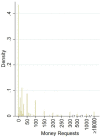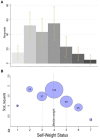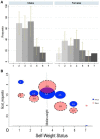Self-identified Obese People Request Less Money: A Field Experiment
- PMID: 27721803
- PMCID: PMC5033972
- DOI: 10.3389/fpsyg.2016.01454
Self-identified Obese People Request Less Money: A Field Experiment
Abstract
Empirical evidence suggests that obese people are discriminated in different social environments, such as the work place. Yet, the degree to which obese people are internalizing and adjusting their own behavior as a result of this discriminatory behavior has not been thoroughly studied. We develop a proxy for measuring experimentally the "self-weight bias" by giving to both self-identified obese (n = 90) and non-obese (n = 180) individuals the opportunity to request a positive amount of money after having performed an identical task. Consistent with the System Justification Theory, we find that self-identified obese individuals, due to a preexisting false consciousness, request significantly lower amounts of money than non-obese ones. A within subject comparison between self-reports and external monitors' evaluations reveals that the excessive weight felt by the "self" but not reported by evaluators captures the self-weight bias not only for obese but also for non-obese individuals. Linking our experimental results to the supply side of the labor market, we argue that self-weight bias, as expressed by lower salary requests, enhances discriminatory behavior against individuals who feel, but may not actually be, obese and consequently exacerbates the wage gap across weight.
Keywords: discrimination; in-group devaluation; obesity; system justification theory; wage-gap; weight-bias.
Figures





Similar articles
-
Obesity Discrimination in the Recruitment Process: "You're Not Hired!".Front Psychol. 2016 May 3;7:647. doi: 10.3389/fpsyg.2016.00647. eCollection 2016. Front Psychol. 2016. PMID: 27199869 Free PMC article.
-
Weight bias among professionals treating eating disorders: attitudes about treatment and perceived patient outcomes.Int J Eat Disord. 2014 Jan;47(1):65-75. doi: 10.1002/eat.22186. Epub 2013 Sep 5. Int J Eat Disord. 2014. PMID: 24038385
-
Do employers discriminate against obese employees? Evidence from individuals who are simultaneously self-employed and working for an employer.Econ Hum Biol. 2021 Aug;42:101017. doi: 10.1016/j.ehb.2021.101017. Epub 2021 May 15. Econ Hum Biol. 2021. PMID: 34049188
-
Weight bias in work settings - a qualitative review.Obes Facts. 2010 Feb;3(1):33-40. doi: 10.1159/000276992. Epub 2010 Feb 11. Obes Facts. 2010. PMID: 20215793 Free PMC article. Review.
-
Bias, discrimination, and obesity.Obes Res. 2001 Dec;9(12):788-805. doi: 10.1038/oby.2001.108. Obes Res. 2001. PMID: 11743063 Review.
Cited by
-
Body image construction and mental health levels among college students: a data survey of Chinese university students.Front Public Health. 2023 Oct 5;11:1268775. doi: 10.3389/fpubh.2023.1268775. eCollection 2023. Front Public Health. 2023. PMID: 37869184 Free PMC article.
-
Body Weight Can Change How Your Emotions Are Perceived.PLoS One. 2016 Nov 21;11(11):e0166753. doi: 10.1371/journal.pone.0166753. eCollection 2016. PLoS One. 2016. PMID: 27870892 Free PMC article.
-
Imitating the winner leads to discrimination in spatial prisoner's dilemma model.Sci Rep. 2019 Mar 7;9(1):3776. doi: 10.1038/s41598-019-40583-w. Sci Rep. 2019. PMID: 30846814 Free PMC article.
References
-
- Ai C., Norton E. (2003). Interaction terms in logit and probit models. Econ. Lett. 80, 123–129. 10.1016/S0165-1765(03)00032-6 - DOI
-
- Akerlof G. A., Kranton R. E. (2000). Economics and identity. Q. J. Econ. 115, 715–753. 10.1162/003355300554881 - DOI
-
- Averett S., Korenman S. (1996). The economic reality of the beauty myth. J. Hum. Resour. 31, 304–330. 10.2307/146065 - DOI
-
- Barron L. A. (2003). Ask and you shall receive? Gender differences in negotiators' beliefs about requests for higher salary. Econ. Hum. Biol. 56, 635–662. 10.1177/00187267030566001 - DOI
LinkOut - more resources
Full Text Sources
Other Literature Sources
Miscellaneous

